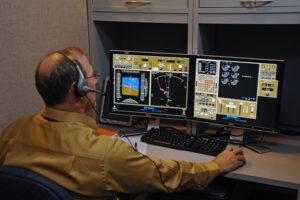
There is a clear national need for ground systems and aircraft, with various autonomous capabilities, to operate in harmony. Operational autonomy research will be used to combat problems of projected pilot and controller shortages and the increasing density of traffic. There are opportunities such as the maturing of CNS technologies, integrated avionics and computing, and a new era of connectivity in the cockpit. Fully autonomous systems are on the near horizon.
Autonomous Flight Rules (AFR) is a visionary NASA operational concept for vehicles (either piloted or unpiloted) operating with trajectory-management autonomy (i.e. maneuver decision-making authority) in airspace shared with vehicles operating conventionally in the NAS under Instrument Flight Rules (IFR). Leveraging airborne surveillance and external data connectivity (e.g. internet access to wind and weather updates), AFR aircraft employ advanced onboard automation that probes for conflicts and computes strategic and tactical “self-separation” resolution maneuvers while following prescribed “rules of the road” and optimizing the aircraft’s trajectory in response to changing environmental conditions and mission needs. NASA’s Autonomous Operations Planner (AOP) is a state-of-the-art software prototype of AFR’s advanced onboard automation, providing an integrated suite of 4D trajectory-management algorithms and capabilities enabling vehicles to self-manage their trajectory in highly complex, dynamic, and dense airspace.
We have prototyped a self-separation and trajectory function in the AOP software. The software uses AFR, which leverage self-separation. The AOP has been stress-tested in complex scenarios with AFR procedures test in collaborative LaRC/ARC simulations by airline pilots and FAA controllers with user costs and implementation strategies analyzed.
The following are benefits of AFR by design:
Safety
Distributed separation functions and responsibility creates redundancy
Employs rigorous rules of coordination
Few single-point failures
Benefits airspace users directly
Provides opportunity for greater flight efficiency and operational flexibility
Eliminates many restrictions and delays of IFR
Immediate fuel/time savings to users
Provides rapid return on investment
Each equipped aircraft receives benefits on first flight while unloading the ground system
No minimum participation required
Works in mixed operations
Facilitates gradual introduction and growth without disruption
Right-of-way goes to existing operation
Scalable with traffic
Distribution minimizes workload bottlenecks which increases capacity
Enables vastly increased traffic densities (e.g., swarms of UAS)
Saves ground system cost
Primary infrastructure is airborne

Self-separation is highly scalable and will see use even in complex traffic environments. AFR operations are compatible with current ATC and IFR w/o segregation. Benefits start with first equipped aircraft, enables viable implementation. Airlines, avionics manufacturers, system integrators and user advocacy groups have all expressed strong support and desire for AFR.
AOP Software Release
Rockwell Collins Advanced Technology Center received the software in 2013. The results were RCI have AOP’s strategic resolution running in their lab, the desire you use AOP in Reduced Crew Operations technology development, and a strategic interest in AFR.
Publications
1. Karr D, Vivona R, Roscoe D, DePascale S, and Wing D. Autonomous Operations Planner: A Flexible Platform for Research in Flight-Deck Support for Airborne Self-Separation. AIAA-2012-5417. 2012.
2. Lewis T, Phojanamongkolkij N, and Wing D. The Effects of Limited Intent Information Availability on Self-Separation in Mixed Operations, 12th Integrated Communications, Navigation, and Surveillance (ICNS), Herndon, VA, 2012.
3. Wing D and Cotton W. For Spacious Skies: Self-Separation with “Autonomous Flight Rules” in US Domestic Airspace. AIAA 2011-6865, 2011.
4. Wing D, Prevot T, Lewis T, Martin L, Johnson S, Cabrall C, Commo S, Homola J, Sheth-Chandra M, Mercer J, and Morey S. Pilot and Controller Evaluations of Separation Function Allocation in Air Traffic Management. 10th USA/Europe ATM R&D Seminar, Chicago, IL, 2013.
5. Consiglio M, Hoadley S, Wing D, Baxley B, and Allen D. Impact of Pilot Delay and Non-Responsiveness on the Safety Performance of Airborne Separation. AIAA-2008-8882, 2008.
6. Idris H, Wing D, Vivona R, and Garcia-Chico J. A Distributed Trajectory-Oriented Approach to Managing Traffic Complexity. AIAA-2007-7731, 2007.
Project Awards
2014 NASA Group Achievement Award
Langley and Ames Separation Assurance Teams
For outstanding research of Separation Assurance concepts to enable the Next Generation of the National Airspace System”
Tech POC: David Wing